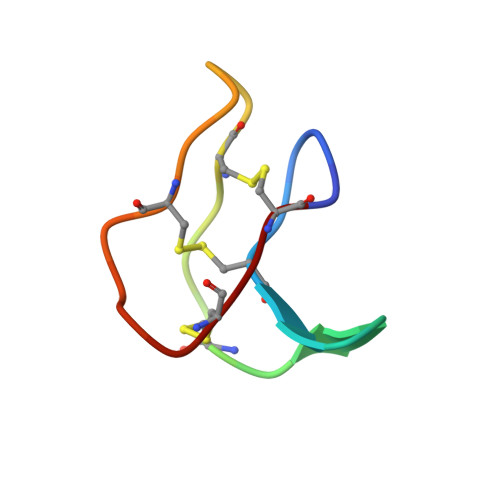Elucidation of the primary and three-dimensional structure of the uterotonic polypeptide kalata B1.
Saether, O., Craik, D.J., Campbell, I.D., Sletten, K., Juul, J., Norman, D.G.(1995) Biochemistry 34: 4147-4158
- PubMed: 7703226
- DOI: https://doi.org/10.1021/bi00013a002
- Primary Citation of Related Structures:
1KAL - PubMed Abstract:
The amino acid sequence and structure of a uterotonic polypeptide extracted from the African plant Oldenlandia affinis DC have been determined. The peptide, kalata B1, consists of 29 amino acid residues and is rich in cysteine (6), threonine (5), and glycine (5). Enzyme cleavage studies show that the polypeptide backbone is cyclic. The three-dimensional solution structure has been determined using two-dimensional nuclear magnetic resonance (NMR) spectroscopy and distance-restrained simulated annealing. Kalata B1 is composed mainly of beta-strands connected by tight turns, forming regions of beta-sheet, except in the case of one section which forms a longer, less structured loop. The tertiary fold, together with the disulfides that form a sulfur core, produces a striking and unusual surface in which the majority of the hydrophobic residues form a solvent-exposed patch. The hydrophobic side of kalata B1 is flanked by two diametrically opposed and opposite-charged residues. The structure calculations have been used to predict the previously unknown disulfide bond connectivities using two approaches. In the first, a family of structures was calculated on the basis of NOE constraints without the assumption of a specific disulfide connectivity. The resultant structures were examined to determine whether the calculated position of the sulfur atoms suggested that one set of disulfide connectivities was more likely than the other, theoretically possible, sets. In the second approach, a separate family of structures (50 per set) was calculated for each of the 15 possible disulfide-bonded molecules. The resultant families of structures were compared to see whether one was favored over the others. Both approaches led to the same global fold, and the most likely disulfide connectivity is predicted to be 5-22, 13-27, and 17-29. In the calculated structure the cyclic peptide backbone is folded back onto itself and braced with disulfide pairs across diagonally opposed beta-strands. This structure involves one of the disulfide bonds (5-22) threading through the eight amino acid loop formed by the other two disulfide bonds and the peptide fragments connecting them.
Organizational Affiliation:
Department of Biochemistry, University of Oxford, United Kingdom.














